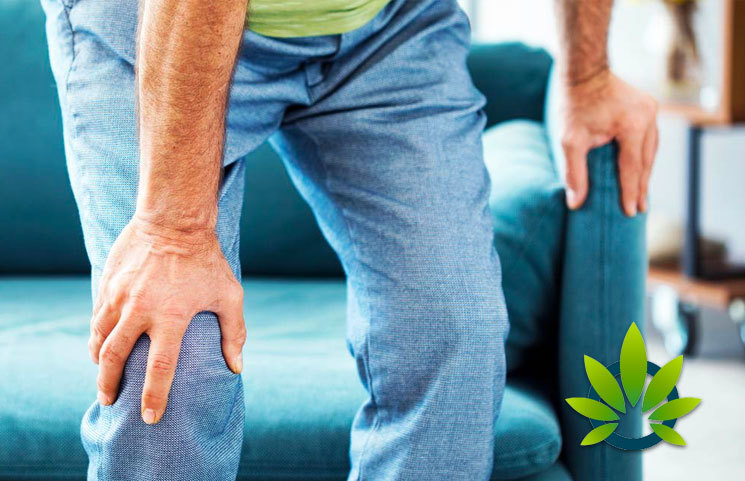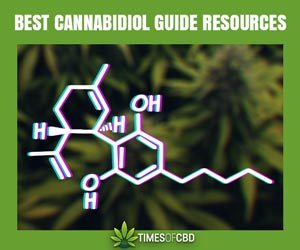CBD for Knee Pain: Does Cannabidiol Benefit Knee Pain?
CBD Oil For Knee Pain: Symptoms, Causes, Diagnosis, Treatment And Prevention Guide

Knee pain is a sensitivity or a swelling in the knee joint that causes immense discomfort to the victims. The pains can either be short term or long term depending on their causes and the extent of the condition or infection.
Knee problems are common which is why everyone should be informed about them for quick assistance before they get grievous. It is hard to determine who is likely to be affected by the problem as they cut across all age groups and gender. Medical projections, however, indicate that adults living a sedentary life are more vulnerable to experience knee pains than any other person. This is because they don’t get to flex and relax their muscles regularly.
Can CBD Help With Knee Pain?
No matter what form pain comes in, it can be extremely unpleasant and it can prevent men and women from experiencing the quality of life that they deserve. One of the worst types of pain that is often debilitating is knee pain. The issue with knee pain is that not only is it difficult to alleviate, but it can also make it challenging to maintain an active and healthy lifestyle. One method to address knee pain in a natural and potentially effective manner is cannabidiol (CBD) based products.
Cannabidiol is derived from marijuana, but unlike the latter, it does not contain tetrahydrocannabinol (THC). The absence of THC ensures that the formula will not cause any psychoactive issues and moreover, it makes the product a legal product as well. Those who are looking to deviate from the normal course of action to address pain – which is to try prescription pain medications that can be additives, then CBD products may be the right route.
One of the major questions that arises is whether CBD is able to address the underlying causes of knee pain. Though there are many forms and signs of knee pain, many times, knee pain is caused by underlying health conditions. A few of the main conditions that can cause knee pain include arthritis, tendinitis, fractures, ACL injury, and dislocation. Other more common causes of knee pain are age and wearing down the joints.
CBD products may work to treat these underlying issues, especially the ones that do not need surgical intervention. That is, the pain associated with the less serious conditions or conditions that have not progressed too far may be best helped by CBD. In this instance, CBD works by reaching the receptors in the body’s endocannabinoid system. This system is responsible for managing one’s digestion, mood, immunity, and more. One of the most important responsibilities of this system is to manage pain.
This is where CBD comes in. Upon reaching the ECS system, it stimulates it to produce more chemicals that mitigate pain. As a result, men and women may be able to experience the relief that they are striving for. Thus, CBD formulas may be effective pain relievers.
In addition to alleviating pain, CBD-based products may also be able to provide other benefits, including reducing inflammation, promoting relaxation, and regulating blood pressure. These benefits are also supported by studies – but keep in mind that there is no conclusive evidence, yet.
Knee Pain Symptoms
Knee pains manifest in different ways depending on their causes. Some of the popular symptoms include:
- Instability or feebleness at the knee joints
- Some unusual crunching sounds
- Stiffness and swellings
- Temperature changes which cause unusual warmth
- Reddening of the knee area
- Constraints when straightening and stretching the knee
Causes Of Knee Pains
The causes of the knee pains are classified into three groups depending on their symptoms; there are pains arising from mechanical activity of the knees, pains from injuries and, those caused by various types of arthritis. Each of the three causes is here separately examined.
Arthritis
There several types of arthritis but the ones which are known for causing knee pains include; Septic arthritis, Rheumatoid arthritis, Osteoarthritis, Gout, and Pseudogout.
- Septic arthritis: It is an infection that attacks the knee leading to swelling, redness and consistent pains. This type of arthritis causes fever when it attacks.
- Rheumatoid arthritis: It is an autoimmune condition that affects most joints in the body. This type of arthritis considerably makes the body weak. Rheumatoid arthritis is a chronic condition, and its severity varies with the victims. Occasionally it can be experienced by some victims once, and it completely fades away while in others it may become chronic.
- Osteoarthritis: It is also known as degenerative arthritis. It is the most popular among all the types of arthritis. It exposes the cartilage to wear and tear especially due to aging. It mostly causes the knee pains in seniors but chances are, it can affect young people as well.
- Gout: It is caused by the excess accumulation of uric acid crystals at the knee joints. Despite being popular for affecting the big toe, occasionally it also affects the knees.
- Pseudogout: The calcium-containing crystals often present in the joint fluid are the common causes of this type of arthritis. This kind of arthritis usually comes along with trauma before the pains begin. The victims also experience fever when it attacks.
Mechanical Knee Pains
The body can also naturally develop problems from movements therefore causing complications to the knees leading to some pains. Pains arising from the mechanical activities of the knees are listed below.
- The Dislocation of the kneecap: Kneecap dislocation occurs when the patella, the bone right over the knee, slides out of place and goes off its usual position. The dislocated cap can be visible if the displacement is extensive.
- Loose body: When the body parts degenerate, they can become loose. Cartilages, ligaments, and tendons are instrumental in holding the body joints together. When they get ruptured due to accidents, wear and tear with age, or due to disease conditions they can fail to hold the body parts together. Alternatively, they can slide in between the bones they are holding, and when pressed in the bones they cause gruesome pain.
- Pains in the hip and foot: Pains at the stated points or any other parts of the body can make a person alter their posture while standing or walking. The change in walking or standing position causes stress to the knees, therefore, leading to the development of pain at the knee joints.
- Iliotibial band syndrome: Iliotibial bands are the tissue bands that run on the outer side of the hip to the knees. The bands can contract and at times become tighter thus rubbing against the protruding part of the femur and cause pains due to friction. The syndrome is mostly experienced by long-distance runners. Running makes people susceptible to the syndrome as the bands get to contract in the process.
Injuries
Knee injuries can either be inherent or physically obtained during accidents. The inherent injuries can result when the tendons, cartilage, ligaments and the bursae (fluid-filled sacs) around the bones at the knee joints are distorted or cut in some way. Some of the frequent cases of knee injuries include:
- Fractures: Knee fractures are most sustained during accidents. However, some arise due to infection by diseases. For instance, severe cases of Osteoporosis can weaken the knee bones so that any wrong steps during movement can make the bones crack by themselves. The bone areas which are prone to such fractures are the facets of femur, tibia, fibula, and patella.
- Knee bursitis: These are inflammations in the bursae. Bursae are the tiny fluid sacs that form the cushion at the joints so that ligaments and tendons can easily glide to facilitate movement.
- ACL injury: Anterior Cruciate Ligament is one of the four ligaments connecting the shinbone to the thighbone. Occasionally, the ligament gets torn especially among the people who do a lot of pounding to their knees like the basketballers and soccer players. These people also make quick turns that can make the ligaments fracture hence causing pain at the joints.
- Patellar tendinitis: When the tendons, the thick fibrous muscles attaching the muscles to the bones are irritated, they cause inflammation on knees. People who frequently engage in jumping sports and Skiers, Runners and Cyclists are prone to develop the condition. This happens because the patella tendon connecting the quadriceps muscle often gets crumbs and irritation from the activities.
- Torn meniscus: The meniscus is the shock absorber between the thighbone and the shinbone. It is made of tough, rubber-like cartilage between the two bones. When an individual bears some weight and attempts to make swift turns, they can end up tearing the cartilage thus causing pains in the torn area.
Diagnosis Of Knee Pains
There are numerous tests performed by doctors to examine the actual causes of the knee pains when they are making diagnostics and prescriptions for the right treatments. Prior to the diagnosis of the conditions, the level of the gravity must be examined to determine the preferred test for the situation. Two main tests can be performed based on the type of the pain. They are laboratory and imaging tests.
Laboratory Test
The test involves taking blood samples if the condition is an infection, gout or pseudogout. These situations are best analyzed through a lab procedure. The situation can also prompt the doctor to remove some fluid from the knee joint for laboratory analysis. This method is best suited for diagnosis of arthrocentesis.
Imaging Tests
The test involves filming the knee to get the image that can be used in the diagnosis. The imaging techniques include:
- X-ray: The process includes taking X-ray films for the examination of fractures and any other possible degenerative diseases at the joints.
- Ultrasound: It is used in the generation of knee images using sound waves. It works well in examining the soft tissues in which different image positions of the knee are taken and used for analysis.
- Magnetic Resonance Imaging (MRI): This technology uses radio waves to produce 3-D images of the knee. It best works in the examination of soft tissues if there are problems with the muscles, tendons, cartilage, and ligaments.
- Computerized Tomography (CT) Scans: This technique entails manipulation of the X-ray images in different orientations by the CT scan in which the cross-sectional images of the knee are observed. It is usually important in the diagnosis of loose bodies and problems within the bones.
Treatment Of Knee Pains
Knee pains can be permanently treated so that the problems can no longer resurface in the future. A permanent solution to the problems, however, largely depends on the diagnosis and correct prescription for medication. Treatments of the knee problems vary depending on the type of the condition and infections. There are four major treatment methods for knee pains.
Oral Medication
This is the simplest method of treatment. Here, the doctor only makes prescriptions for particular drugs which are administered orally for treatment. This method is preferred in the treatment of gout and arthritis.
Therapy
Therapy is most important in muscle activation in the affected areas to make them stronger and stable. It can entail series of training that stretch and flex the front and back muscles of the thigh. Performing some sub-optimal motions and exercises restore the fatigue felt in the affected areas while improving balance at the joints.
The process may require the use of arch supports and wedges to enhance pressure balance compromised by conditions like arthritis. It may also necessitate the use of braces to support and protect the knee during the therapeutic procedures.
Injections
Some of the conditions require treatment through injections. This is done through the injectable parts of the body and in most instances right on the painful knee. Some of the drugs administered this way include;
- Corticosteroids: The injection is performed on the knee and provides significant pain relief after the process. It is often used in the management of arthritis. In some cases, the injection is not effective as anticipated.
- Platelet Rich Plasma (PRP): It reduces inflammation and enhances healing by inducing growth since the injection contains elements of growth concentration factors. It is a recommended medication in the treatment of mild arthritis in young people.
- Hyaluronic acid: It is a thick fluid equivalent to natural joint lubricant purposefully injected into the knee to reduce pain and enhance mobility by reducing friction. Studies have not established how effective the drug can be, but most patients have observed that after some injections they are relieved of pain nearly for six months.
Surgical Procedures
Surgery is often the most effective way of treating knee problems. These procedures take the shortest time as patients are released to recuperate soon afterwards. Patients who undergo perfectly conducted procedures hardly complain of similar pains in future. The common options in the procedures include;
- Partial knee replacement: In this procedure, an orthopedic replaces the damaged part of the knee with artificial parts made of plastics or metals which work just like the initial removed part. The process can be a simple incision that takes few days to heal.
- Total knee replacement: The procedure entails removal of the painful parts of the shinbone, thighbone, and kneecap and artificial joints are put in their place. The artificial joint is usually made up of polymers, quality, and effective plastics or metal alloys. It may take some few weeks to heal, but the procedure offers a permanent solution to knee pains.
- Arthroscopic surgery: This procedure involves the use of fiber optic cameras with other tools inserted into the knee through an incision. The damage can then be examined and repaired depending on its magnitude. The method is effective in elimination and restoring loose bodies, cartilage, and reconstruction of ligaments.
CBD Treatment
When choosing a CBD formula, one consideration that individuals need to take into account is the treatment method that may work best for them. There are several treatment method that users may want to consider, such as:
- Tinctures
- Topical Application
- Smoking or Vaping
In terms of fastest-acting formulas, the best options are tinctures and smoking or vaping. Topical applications may not only be slower, but messier as well. On the other hand, topical applications may be best for those who do not like to smoke or vape, or who do not want to consume a tincture.
Keep in mind that even though CBD is legal, it is important to discuss using CBD as a pain mitigation method with one’s doctor before going forward. This way, men and women can ensure that they are making the best decision for their needs.
How To Prevent Experiencing Knee Problems
Knee problems, like most diseases, are also preventable. This is achievable by observing the activities listed here:
- Watch your diet to avoid adding excess weight to your body
- Engage in regular exercises to keep your muscles active to stay fit and flexible
- Walk in the right posture to exert proportional weight on your knees
- Seek regular medical check-ups for arthritis
It is advisable to visit a doctor for an examination, diagnosis, and treatment of the conditions before they get out proportion.





